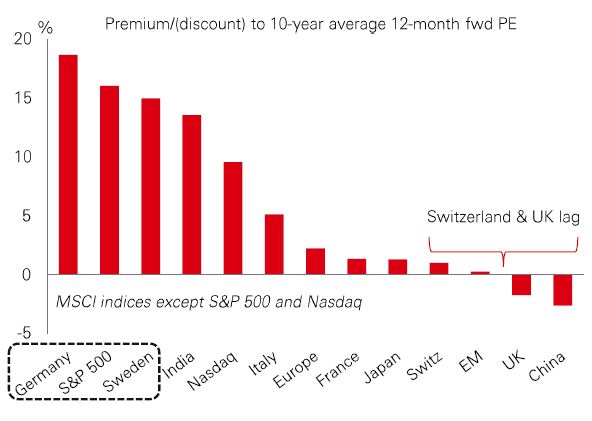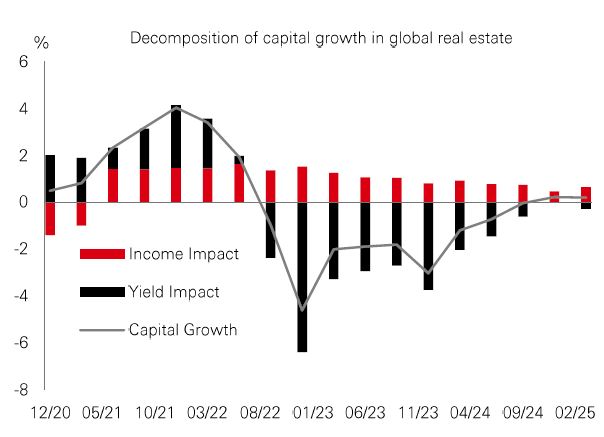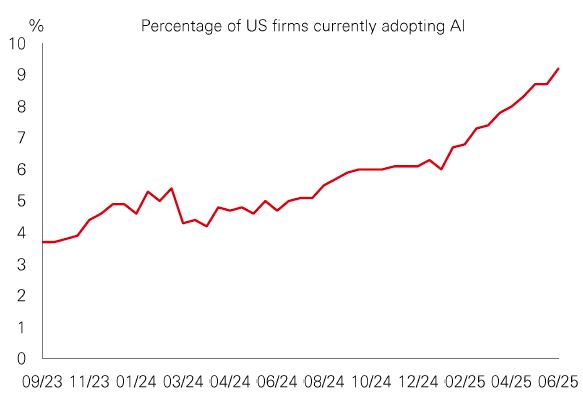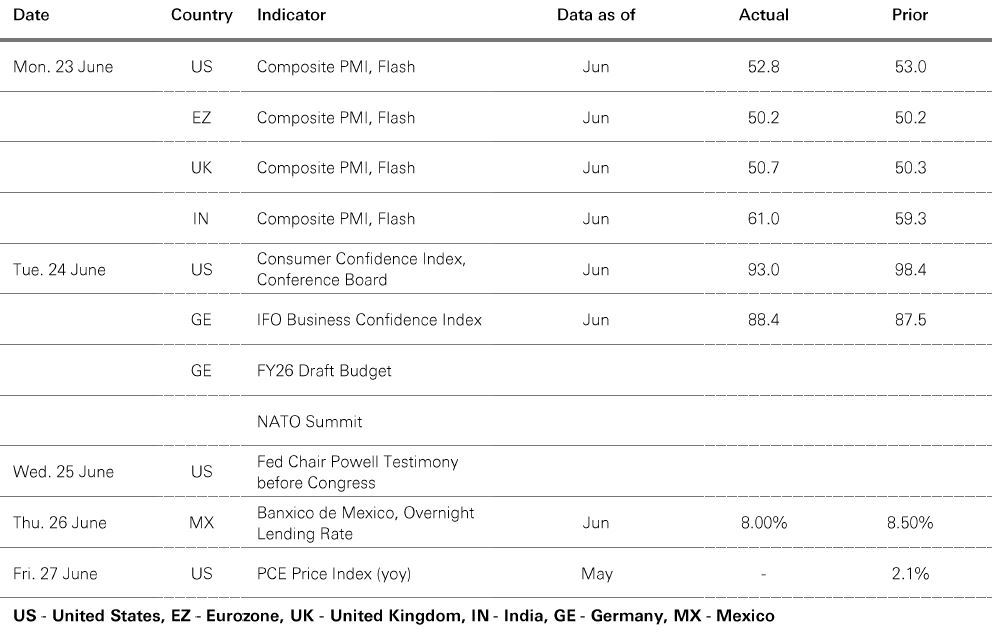
30 June 2025

What can investors expect from markets in the second half of 2025? So far this year, fading US exceptionalism has been a defining feature of the investment landscape. For years, US leadership has been characterised by relatively strong GDP growth, outsized stock market returns, and the strength of the dollar. For markets, it has been dollar weakness in particular, that has influenced returns in the first half – and that looks set to continue.
The H1 headline is that US stocks have underperformed the rest of the world. A weaker dollar, cooling US growth, and higher levels of uncertainty – driven by unpredictable policy – have driven investors to look further afield for superior risk-adjusted returns. That’s seen a switch in equity leadership to Europe, the Far East, and emerging markets (EM), and value outperforming growth. Dollar weakness has created new policy space for EM central banks, with proactive rate cuts – in contrast to a reactive Fed – oxygenating EM bonds and stocks, which have long been under-owned in the era of US exceptionalism. Meanwhile, stronger EM currencies have boosted the appeal of local bonds to global investors.
Meanwhile, a regime of “deficits forever” and a cautious Fed have kept 10-year Treasury yields high in H1, limiting returns and impairing their traditional role in protecting portfolios. Selective credits, real assets and liquid diversifiers like hedge funds and infrastructure have been positive. And the price of gold – a natural haven in uncertainty – has soared.
As pressure builds on risk-adjusted returns, it is important that investors are ready to adapt. Staying nimble and embracing tactical asset allocations will be key to navigating inherently unsettled markets.
Asian stock markets were volatile in the first six months of 2025 – but there were some stellar returns. The MSCI Asia ex-Japan index is up 13% year to date in USD terms, eclipsing US gains. Fading US exceptionalism (especially a weaker dollar) is a catalyst for the rest of the world assets.
A solid performance in China (+19%, USD) was helped by tech sector strength – including advances at AI firm DeepSeek – progress on a US trade deal, and an ongoing policy put.
Meanwhile, South Korea (+32%) set the pace on post-election expectations of fresh policy stimulus and corporate governance reforms, as well as an AI-demand led semiconductor sector recovery. Hong Kong (+18%) was buoyed by lower local rates and a pick-up in trading activity and new listings. And Taiwan posted a 5% gain in H1 but saw a strong pick-up in Q2 largely attributable to FX effects. Overall, some equity analysts continue to see Asia offering broad sector diversification and quality-growth opportunities at reasonable valuations – but selectivity is key.
The value of investments and any income from them can go down as well as up and investors may not get back the amount originally invested. Past performance does not predict future returns. The level of yield is not guaranteed and may rise or fall in the future. For informational purposes only and should not be construed as a recommendation to invest in the specific country, product, strategy, sector, or security. Diversification does not ensure a profit or protect against loss. Any views expressed were held at the time of preparation and are subject to change without notice. Any forecast, projection or target where provided is indicative only and is not guaranteed in any way. Source: HSBC Asset Management, Bloomberg. See page 8 for details of asset class indices. Data as at 7.30am UK time 27 June 2025.
European stocks have outperformed most global markets in 2025. It follows 15 years of underperformance versus the US – leaving it at a deep valuation discount coming into 2025. The main catalyst was fading US exceptionalism and ultra-high policy uncertainty, which delivered a wake-up call for both European policymakers and investors. Germany’s decision to open the fiscal taps to fund spending on defence and industry was key and raises the prospect of renewed growth across the bloc. A backdrop of falling inflation and ECB policy easing has also helped. Europe’s valuation discount has compressed lately – but there’s still a wide gap with the US. The forward price/earnings ratio of the MSCI eurozone index re-rated to 14.5x from 13x in H1, taking it above its 10-year average. And the German index now trades at a near-20% premium to its 10-year average PE, on strength in its aerospace and industrials sectors. That’s more than the S&P 500, with Sweden close behind. |
Year-on-year 2025 eurozone profit growth expectations have fallen to 4% on tariff and currency risk, but it looks set to rise to 11.5% in 2026. Despite the H1 rally, some equity analysts see pockets of exceptional value in wider Europe to keep investors happy.

After a challenging period marked by higher financing costs and policy uncertainty, fundamentals in direct real estate are stabilising and liquidity is improving. Capital values are expected to edge upward in the next 12-months, driven by income-led growth, instead of property yield compression. But this recovery may not be uniform across sectors. Retail is one to watch. Long overlooked, it’s re-emerging as a strong performer. Vacancy rates are near historic lows in markets like the US and Tokyo, and rents are rising on the back of a healthier, more resilient tenant base. Yields also remain attractive compared to other sectors. |
Looking ahead, senior housing and data centres may also continue to lead the charge in non-traditional segments. Powered by AI, cloud infrastructure, and demographic tailwinds, these areas show sustained rental growth and rising demand. With alternative asset classes playing a key role as portfolio diversifiers, some specialists believe that with careful consideration and a long-term view, investors can find opportunities in a real estate market entering a more balance and income-driven phase.

Investor focus has been centred on downside risks this year. But it is important to remember upside risks too. One obvious channel is an AI-led productivity rebound. Almost 9.2% of US firms now use AI, almost double last year’s rate, with financial, IT, and educational sectors leading the charge. Academic studies suggest AI can lift labour productivity by 25% on average. Longer-term, this could have significant upside implications for aggregate output, consumption, investment, and R&D. Of course, the pace and breadth of these gains hinges on how quickly firms adapt, how AI diffuses across sectors, and how issues like data privacy and outdated tech stacks are tackled. |
For markets, increased efficiency could drive corporate profits higher for firms leveraging AI effectively, resulting in upside for equity prices. Meanwhile, bond yields could also see upward pressure amid higher growth that raises demand for capital and pushes r* (the neutral rate) higher. But like all big technological leaps, it won’t be straightforward. Some job losses are likely, while inflation could drop on faster supply growth. Expect this issue to add to uncertainty in the coming years.

Past performance does not predict future returns. The level of yield is not guaranteed and may rise or fall in the future. For informational purposes only and should not be construed as a recommendation to invest in the specific country, product, strategy, sector, or security. Diversification does not ensure a profit or protect against loss. Any views expressed were held at the time of preparation and are subject to change without notice. Index returns assume reinvestment of all distributions and do not reflect fees or expenses. You cannot invest directly in an index. Any forecast, projection or target where provided is indicative only and is not guaranteed in any way. Source: HSBC Asset Management. Macrobond, Bloomberg. Data as at 7.30am UK time 27 June 2025.


Source: HSBC Asset Management. Data as at 7.30am UK time 27 June 2025. For informational purposes only and should not be construed as a recommendation to invest in the specific country, product, strategy, sector or security. Any views expressed were held at the time of preparation and are subject to change without notice. Any forecast, projection or target where provided is indicative only and is not guaranteed in any way.
Easing geopolitical tensions boosted risk markets, with oil prices declining markedly, and the US dollar continued its recent downtrend against major currencies. US Treasury yields fell amid growing Fed rate cut expectations, driven by some dovish remarks from Fed officials and soft macro data, while rising fiscal concerns weighed on German Bunds. Global equities rose, as robust gains in US tech sector propelled the S&P 500 and Nasdaq Composite close to their all-time highs. In Europe, the Euro Stoxx 50 index was on course to post modest gains. In Asia, equity markets saw broad-based advances, led by Japan’s Nikkei 225, with Chinese equities also rallying. In Latin America, Brazil’s Bovespa index traded sideways while Mexico’s IPC closed higher.






This document or video is prepared by The Hongkong and Shanghai Banking Corporation Limited (‘HBAP’), 1 Queen’s Road Central, Hong Kong. HBAP is incorporated in Hong Kong and is part of the HSBC Group. This document or video is distributed and/or made available, HSBC Bank (China) Company Limited, HSBC Bank (Singapore) Limited, HSBC Bank Middle East Limited (UAE), HSBC UK Bank Plc, HSBC Bank Malaysia Berhad (198401015221 (127776-V))/HSBC Amanah Malaysia Berhad (20080100642 1 (807705-X)), HSBC Bank (Taiwan) Limited, HSBC Bank plc, Jersey Branch, HSBC Bank plc, Guernsey Branch, HSBC Bank plc in the Isle of Man, HSBC Continental Europe, Greece, The Hongkong and Shanghai Banking Corporation Limited, India (HSBC India), HSBC Bank (Vietnam) Limited, PT Bank HSBC Indonesia (HBID), HSBC Bank (Uruguay) S.A. (HSBC Uruguay is authorised and oversought by Banco Central del Uruguay), HBAP Sri Lanka Branch, The Hongkong and Shanghai Banking Corporation Limited – Philippine Branch, HSBC Investment and Insurance Brokerage, Philippines Inc, and HSBC FinTech Services (Shanghai) Company Limited and HSBC Mexico, S.A. Multiple Banking Institution HSBC Financial Group (collectively, the “Distributors”) to their respective clients. This document or video is for general circulation and information purposes only.
The contents of this document or video may not be reproduced or further distributed to any person or entity, whether in whole or in part, for any purpose. This document or video must not be distributed in any jurisdiction where its distribution is unlawful. All non-authorised reproduction or use of this document or video will be the responsibility of the user and may lead to legal proceedings. The material contained in this document or video is for general information purposes only and does not constitute investment research or advice or a recommendation to buy or sell investments. Some of the statements contained in this document or video may be considered forward looking statements which provide current expectations or forecasts of future events. Such forward looking statements are not guarantees of future performance or events and involve risks and uncertainties. Actual results may differ materially from those described in such forward-looking statements as a result of various factors. HBAP and the Distributors do not undertake any obligation to update the forward-looking statements contained herein, or to update the reasons why actual results could differ from those projected in the forward-looking statements. This document or video has no contractual value and is not by any means intended as a solicitation, nor a recommendation for the purchase or sale of any financial instrument in any jurisdiction in which such an offer is not lawful. The views and opinions expressed are based on the HSBC Global Investment Committee at the time of preparation and are subject to change at any time. These views may not necessarily indicate HSBC Asset Management‘s current portfolios’ composition. Individual portfolios managed by HSBC Asset Management primarily reflect individual clients’ objectives, risk preferences, time horizon, and market liquidity.
The value of investments and the income from them can go down as well as up and investors may not get back the amount originally invested. Past performance contained in this document or video is not a reliable indicator of future performance whilst any forecasts, projections and simulations contained herein should not be relied upon as an indication of future results. Where overseas investments are held the rate of currency exchange may cause the value of such investments to go down as well as up. Investments in emerging markets are by their nature higher risk and potentially more volatile than those inherent in some established markets. Economies in emerging markets generally are heavily dependent upon international trade and, accordingly, have been and may continue to be affected adversely by trade barriers, exchange controls, managed adjustments in relative currency values and other protectionist measures imposed or negotiated by the countries with which they trade. These economies also have been and may continue to be affected adversely by economic conditions in the countries in which they trade. Investments are subject to market risks, read all investment related documents carefully.
This document or video provides a high-level overview of the recent economic environment and has been prepared for information purposes only. The views presented are those of HBAP and are based on HBAP’s global views and may not necessarily align with the Distributors’ local views. It has not been prepared in accordance with legal requirements designed to promote the independence of investment research and is not subject to any prohibition on dealing ahead of its dissemination. It is not intended to provide and should not be relied on for accounting, legal or tax advice. Before you make any investment decision, you may wish to consult an independent financial adviser. In the event that you choose not to seek advice from a financial adviser, you should carefully consider whether the investment product is suitable for you. You are advised to obtain appropriate professional advice where necessary.
The accuracy and/or completeness of any third-party information obtained from sources which we believe to be reliable might have not been independently verified, hence Customer must seek from several sources prior to making investment decision.
The following statement is only applicable to HSBC Mexico, S.A. Multiple Banking Institution HSBC Financial Group with regard to how the publication is distributed to its customers: This publication is distributed by Wealth Insights of HSBC México, and its objective is for informational purposes only and should not be interpreted as an offer or invitation to buy or sell any security related to financial instruments, investments or other financial product. This communication is not intended to contain an exhaustive description of the considerations that may be important in making a decision to make any change and/or modification to any product, and what is contained or reflected in this report does not constitute, and is not intended to constitute, nor should it be construed as advice, investment advice or a recommendation, offer or solicitation to buy or sell any service, product, security, merchandise, currency or any other asset.
Receiving parties should not consider this document as a substitute for their own judgment. The past performance of the securities or financial instruments mentioned herein is not necessarily indicative of future results. All information, as well as prices indicated, are subject to change without prior notice; Wealth Insights of HSBC Mexico is not obliged to update or keep it current or to give any notification in the event that the information presented here undergoes any update or change. The securities and investment products described herein may not be suitable for sale in all jurisdictions or may not be suitable for some categories of investors.
The information contained in this communication is derived from a variety of sources deemed reliable; however, its accuracy or completeness cannot be guaranteed. HSBC México will not be responsible for any loss or damage of any kind that may arise from transmission errors, inaccuracies, omissions, changes in market factors or conditions, or any other circumstance beyond the control of HSBC. Different HSBC legal entities may carry out distribution of Wealth Insights internationally in accordance with local regulatory requirements.
Important Information about the Hongkong and Shanghai Banking Corporation Limited, India (“HSBC India”)
HSBC India is a branch of The Hongkong and Shanghai Banking Corporation Limited. HSBC India is a distributor of mutual funds and referrer of investment products from third party entities registered and regulated in India. HSBC India does not distribute investment products to those persons who are either the citizens or residents of United States of America (USA), Canada or New Zealand or any other jurisdiction where such distribution would be contrary to law or regulation.
The following statement is only applicable to HSBC Bank (Taiwan) Limited with regard to how the publication is distributed to its customers: HSBC Bank (Taiwan) Limited (“the Bank”) shall fulfill the fiduciary duty act as a reasonable person once in exercising offering/conducting ordinary care in offering trust services/ business. However, the Bank disclaims any guarantee on the management or operation performance of the trust business.
The following statement is only applicable to PT Bank HSBC Indonesia (“HBID”): PT Bank HSBC Indonesia (“HBID”) is licensed and supervised by Indonesia Financial Services Authority (“OJK”). Customer must understand that historical performance does not guarantee future performance. Investment product that are offered in HBID is third party products, HBID is a selling agent for third party product such as Mutual Fund and Bonds. HBID and HSBC Group (HSBC Holdings Plc and its subsidiaries and associates company or any of its branches) does not guarantee the underlying investment, principal or return on customer investment. Investment in Mutual Funds and Bonds is not covered by the deposit insurance program of the Indonesian Deposit Insurance Corporation (LPS).
Important information on ESG and sustainable investing
Today we finance a number of industries that significantly contribute to greenhouse gas emissions. We have a strategy to help our customers to reduce their emissions and to reduce our own. For more information visit www.hsbc.com/sustainability.
In broad terms “ESG and sustainable investing” products include investment approaches or instruments which consider environmental, social, governance and/or other sustainability factors to varying degrees. Certain instruments we classify as sustainable may be in the process of changing to deliver sustainability outcomes. There is no guarantee that ESG and Sustainable investing products will produce returns similar to those which don’t consider these factors. ESG and Sustainable investing products may diverge from traditional market benchmarks. In addition, there is no standard definition of, or measurement criteria for, ESG and Sustainable investing or the impact of ESG and Sustainable investing products. ESG and Sustainable investing and related impact measurement criteria are (a) highly subjective and (b) may vary significantly across and within sectors.
HSBC may rely on measurement criteria devised and reported by third party providers or issuers. HSBC does not always conduct its own specific due diligence in relation to measurement criteria. There is no guarantee: (a) that the nature of the ESG / sustainability impact or measurement criteria of an investment will be aligned with any particular investor’s sustainability goals; or (b) that the stated level or target level of ESG / sustainability impact will be achieved. ESG and Sustainable investing is an evolving area and new regulations are being developed which will affect how investments can be categorised or labelled. An investment which is considered to fulfil sustainable criteria today may not meet those criteria at some point in the future.
THE CONTENTS OF THIS DOCUMENT OR VIDEO HAVE NOT BEEN REVIEWED BY ANY REGULATORY AUTHORITY IN HONG KONG OR ANY OTHER JURISDICTION. YOU ARE ADVISED TO EXERCISE CAUTION IN RELATION TO THE INVESTMENT AND THIS DOCUMENT OR VIDEO. IF YOU ARE IN DOUBT ABOUT ANY OF THE CONTENTS OF THIS DOCUMENT OR VIDEO, YOU SHOULD OBTAIN INDEPENDENT PROFESSIONAL ADVICE.
© Copyright 2025. The Hongkong and Shanghai Banking Corporation Limited, ALL RIGHTS RESERVED.
No part of this document or video may be reproduced, stored in a retrieval system, or transmitted, on any form or by any means, electronic, mechanical, photocopying, recording or otherwise, without the prior written permission of The Hongkong and Shanghai Banking Corporation Limited.